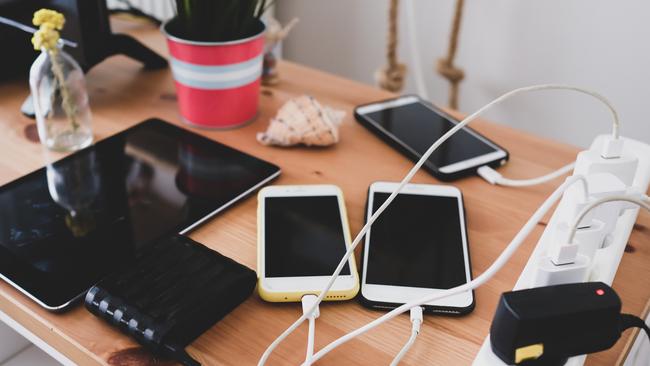10 home appliances most costly for energy – and the 10 cheapest
Discover the 10 most expensive appliances to run in your home, and the cheapest, to help save a small fortune on living costs.
SmartDaily
Don't miss out on the headlines from SmartDaily. Followed categories will be added to My News.
Knowledge is power in the world of power, and it begins by understanding how much you pay to run your household appliances.
As electricity prices surge across Australia – more than 20 per cent in some states – consumers are being urged to examine what guzzles the most energy.
Canstar Blue energy specialist Christine Seib says if you know what costs the most, you can adjust your behaviour to reduce use where possible.
While heating and cooling are the biggest energy burners, smaller appliances such as clothes dryers and dishwashers can add close to $100 each to annual electricity bills, Seib says.
“It’s simple – run these less often to save money,” she says.
“Switch off standby settings on appliances and devices when they’re not in use.
“Using standby power – that’s when something’s plugged in and using power when not in use – adds up to around $90 a year … but for households that have multiple TVs, ACs or gaming consoles, it could be much more.”
Solar energy, hot water and appliance company Chromagen’s head of retail, Daniel Clark, says it is crucial to understand what pressures your power bill.
“Using hot water as an example, the average electric hot water unit uses just under $1000 a year in power,” he says.
“By switching it out with a more economical unit you could save $600, which is a whopping 60 per cent.”
Clark says heating and cooling make up about 40 per cent of household power bills, with hot water on 30 per cent and washing machines/dryers and lighting at 12 per cent each.
“Doing basic things like turning off unnecessary lights, using natural lights, washing laundry in cold water, and unplugging that second unneeded fridge can add up to savings,” he says.
“Taking just one minute off the shower time would save the average family of four $80 a year.”
Let’s take a tour of a typical home to discover the energy impacts, based on distributor Ausgrid’s appliance usage guide and average capital city electricity prices.

KITCHEN
Your refrigerator, running 24-7, is the most expensive appliance to run in the kitchen, but its cost can vary dramatically depending on its age.
A new 400-litre fridge costs an average $120 annually to operate – less than half that of a 20-year-old fridge’s $262 a year. A larger new fridge holding 650 litres is still much cheaper than the older model, costing an average $164 annually.
Other kitchen items are energy-intensive but we don’t use them as often. For example, a kettle needs 2400 watts – about 35 times as much as a 68-watt new fridge – but it only runs an average 25 hours a year so costs $12 to operate.
Dishwashers are the second most expensive kitchen appliance when it comes to energy use, followed by electric woks and frying pans. Your microwave oven uses about $20 of electricity a year.
LAUNDRY
The clothes dryer is one of the home’s most expensive appliances to run, requiring 4000 watts and costing 81c per load. Using the dryer twice a week results in an annual cost near $80, but some households turn theirs on much more frequently.
A washing machine running on a warm cycle costs just over 18c per load, or $73 a year.
“Choosing to wash your laundry with cold water can make an enormous difference,” Clark says.
“Besides the cost savings, washing in cold water actually helps your clothes last longer and colours don’t fade as fast.
“Hot water is a real energy zapper. If you are worried that cold washes do not sanitise clothes, simply purchase a laundry sanitiser from the supermarket.”

HEATING AND COOLING
Airconditioners and heaters come in many shapes and sizes and running costs vary widely, but they are typically a home’s most expensive appliances.
A ducted airconditioner costs more than $1.20 an hour to operate, a large wall unit costs 71c per hour, while underfloor heating in a living room is 73c an hour. At the other end of the cost curve, a ceiling fan costs 1.8c an hour or $8.80 a year, and a pedestal fan even less – 1c an hour or $4.80 a year.
Canstar Blue’s Seib suggests thinking “old school” about energy use.
“When heating, throw on a jumper and set your thermostat to 18- 22 degrees because each degree above can add up to 10 per cent to your heating costs,” she says.
“In summer, strip off – within reason – and set the airconditioner’s temperature to 25-26 degrees because every degree below 25 can add around 10 per cent to its running costs.
“Close your doors and curtains and block drafts to allow your heating and cooling appliances to maintain these temperatures.”
If you use an electric blanket for toasty warmth at bedtime, the good news is it only costs 2.4c an hour to run, about $8 a year.
HOME OFFICE
Working from home gives people handy tax deductions for energy use, but apart from heating and cooling the costs are not great.
A printer costs $2 a year, computer and monitor $10 annually, modem $8.80 and scanner just 80c a year. Mobile phone chargers use just 0.1c an hour or $8.80 a year, but families charging many devices daily may find their combined cost adds up.
POOL PAIN
If you own a swimming pool, you’re probably paying a small fortune to power it.
It can cost $1840 annually to run a heat pump pool heater, $404 a year to run a pool pump, $364 annually to run a spa, and $110 to run a saltwater chlorinator. These are not technically home appliances, but their combined impact can be greater than any airconditioner.

APPLIANCE AVERAGE ANNUAL COST
HIGHEST
Ducted airconditioner $1212
Hot water unit $1000
Waterbed $708
Large wall airconditioner $707
Fridge (400L 20 years old) $262
Fridge (400L new) $120
Dishwasher $97
Clothes dryer $89
Electric wok $80
Washing machine (warm cycle) $73
LOWEST
Shaver 40c
Printer $2
Juicer $3.20
Clock radio $3.60
Rangehood $4.40
Pedestal fan $4.80
Toaster $5.20
DVD/video player $5.20
Blender $6
Mobile phone charger $8.80
Source: Ausgrid, Chromagen, Canstar (based on average electricity prices across NSW, Vic, SA and Qld)
Originally published as 10 home appliances most costly for energy – and the 10 cheapest





